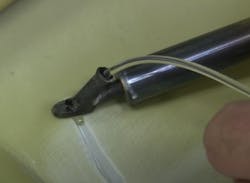Why isn't the welding rod sticking to this PUR bumper?
Question: Why isn’t the welding rod sticking to this PUR bumper?
Answer:
Bumpers made from PUR, or thermoset polyurethane, are not very common today. This was a very common material on domestic car bumpers from the ’70s through the ’90s, and there are still a few applications today, like the Dodge Challenger rear bumper. However, most plastic bumpers today are made of polypropylene (PP) blends.
Most plastics are “thermoplastic”, or meltable plastics, so technicians are more familiar with these types. Technicians are less familiar with the “thermoset” plastics, like polyurethane. These types of plastics are not meltable because they form a solid through a chemical reaction. If you try to melt the plastic, it chemically breaks it down and destroys it.
The mistake most technicians make when trying to weld a polyurethane bumper is that they try to melt the base material with the welder. This causes the base material to break down, forming a sticky liquid on the surface. The welding rod peels right off the liquid.
What’s the right way to do it? Think of a “weld” repair on a polyurethane bumper more like a braze or a hot melt glue. First of all, since it’s actually an adhesive repair, you need to prepare the surface properly by cleaning and sanding it to get some good sandscratches into the surface. Then you want to melt the thermoplastic urethane (TPU) welding rod onto the prepared surface without overheating the base material. You can do this by holding the welding tip just off the surface and use the welder more like a hot melt glue gun.
Information provided by Polyvance
About the Author

Kurt Lammon
President, Polyvance
Kurt Lammon, president of Polyvance since 1995, has a bachelor's degree in mechanical engineering and a minor in material science. He has been focused on developing and manufacturing products to help auto body technicians and DIY-ers repair damaged plastic parts. Polyvance has specialized in plastic repair products since 1981. The company was founded as Urethane Supply Company by Jim Sparks who invented the original airless plastic welder to repair the thermoset polyurethane bumpers that were popular in the '70s and '80s. Since that time, the company has introduced several innovations, including the Uni-Weld FiberFlex universal welding rod, Bumper & Cladding Coat Adhesion Primer, and the Nitro-Fuzer nitrogen plastic welding system. Polyvance is an I-CAR Sustaining Partner and provides several hands-on and virtual training courses on plastic repair and refinishing.
